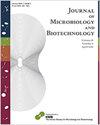对真菌引起的碳酸盐和纤维素古迹劣化的自然抑制处理:生物劣化的分离、鉴定和模拟。
IF 3.1
4区 生物学
Q3 BIOTECHNOLOGY & APPLIED MICROBIOLOGY
引用次数: 0
摘要
真菌在各类古迹的退化过程中扮演着重要角色。因此,保护古迹免受真菌侵袭是一个重要目标,必须引起全世界研究人员的关注。我们从埃及开罗埃及文明国家博物馆(NMEC)储藏室中的 22 件损坏文物(包括纸张、纺织品、木材和石材)中共分离出 69 株真菌。经鉴定,这些分离物有 12 个不同的种类,分为三个不同的属,即曲霉属(9 个种)、青霉属(2 个种)和毛霉属(1 个种)。其中,烟曲霉是最常见的菌种。对三种精油的抗真菌活性进行了评估,并与五种合成杀微生物剂的抗真菌效果进行了比较,以确定一种天然的抑制处理方法。结果发现,百里香精油和叠氮化钠是最有效的生长抑制剂,最低抑制浓度(MICs)分别为 625 和 100 ppm,抑制区直径分别为 19.0 ± 0.70 - 23.76 ± 1.15 和 13.30 ± 0.35 - 19.66 ± 0.54 mm。使用烟曲霉菌株 NMEC-PSTW.1 孢子对纸张、纺织品、木材和石材制成的模型立方体进行了生物劣化过程的体外模拟。使用环境扫描电子显微镜/能量色散 X 射线光谱仪和傅立叶变换红外光谱仪分析了人工劣化材料特性的变化。结果显示,百里香酵母菌 NMEC-PSTW.1 引发了形态、物理性质和化学成分的变化。总之,建议将百里香油作为一种天然抑制剂,以保护 NMEC 中的碳酸盐和纤维素古迹免受真菌侵袭。本文章由计算机程序翻译,如有差异,请以英文原文为准。
Natural Inhibitory Treatment of FungiInduced Deterioration of Carbonate and Cellulosic Ancient Monuments: Isolation, Identification and Simulation of Biogenic Deterioration.
Fungi play a significant role in the deterioration of various types of monuments. Therefore, the protection of ancient monuments from fungal attacks is an important goal that must attract the attention of researchers worldwide. A total of 69 fungal isolates were recovered from 22 deteriorated objects compromising paper, textiles, wood, and stone in the National Museum of Egyptian Civilization (NMEC) storeroom, Cairo, Egypt. The isolates were identified as 12 different species categorized into three different genera, namely, Aspergillus (9 species), Penicillium (2 species) and Trichoderma (1 species). Among them, Aspergillus fumigatus was the most prevalent species. Three essential oils were assessed for antifungal activity and compared with the antifungal effects of five synthetic microcides to identify a natural inhibitory treatment. Thyme oil and sodium azide were found to be the most active growth inhibitors, with minimum inhibitory concentrations (MICs) of 625 and 100 ppm, with inhibition zone diameters of 19.0 ± 0.70 - 23.76 ± 1.15 and 13.30 ± 0.35 - 19.66 ± 0.54 mm, respectively. An in vitro simulation of the biodeterioration process was conducted using spores of the A. fumigatus strain NMEC-PSTW.1 on model cubes made of paper, textile, wood, and stone materials. The changes in the characteristics of the artificially deteriorated materials were analyzed using environmental scanning electron microscopy/energy dispersive X-ray spectroscopy and Fourier transform infrared spectroscopy. The results revealed changes in the morphology, physical properties, and chemical composition induced by A. fumigatus NMEC-PSTW.1. Overall, thyme oil is recommended as a natural inhibitor to protect carbonate and cellulosic monuments in NMEC against fungal attack.
求助全文
通过发布文献求助,成功后即可免费获取论文全文。
去求助
来源期刊

Journal of microbiology and biotechnology
BIOTECHNOLOGY & APPLIED MICROBIOLOGY-MICROBIOLOGY
CiteScore
5.50
自引率
3.60%
发文量
151
审稿时长
2 months
期刊介绍:
The Journal of Microbiology and Biotechnology (JMB) is a monthly international journal devoted to the advancement and dissemination of scientific knowledge pertaining to microbiology, biotechnology, and related academic disciplines. It covers various scientific and technological aspects of Molecular and Cellular Microbiology, Environmental Microbiology and Biotechnology, Food Biotechnology, and Biotechnology and Bioengineering (subcategories are listed below). Launched in March 1991, the JMB is published by the Korean Society for Microbiology and Biotechnology (KMB) and distributed worldwide.
 求助内容:
求助内容: 应助结果提醒方式:
应助结果提醒方式:


